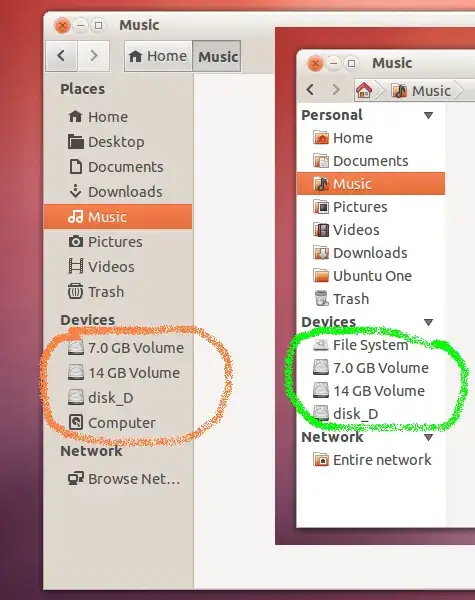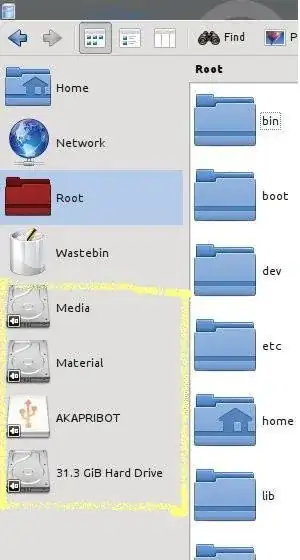I don't know what files or file types are there on the hard drive nor do I know the file system in which the hard disk is written on. I am not able to view it in the home folder after booting from the liveCD.
-
Does Gparted not tell you what filesystems you have on your disk? (As I remember it should do) – Peterling Sep 18 '12 at 17:02
-
1You should nt look in Home Folder, but on the left pane of Nautilus, identify the correct partition and mount it. With that said, this question lacks detail, and it would help to add some. – nanofarad Sep 18 '12 at 20:34
2 Answers
When running a live session, you cannot access a computer's hard drive via /home directory or Home folder.
You do need to identify and click on the partition's label or name in the side pane of Nautilus to mount it, that is if you are running Ubuntu with GNOME desktop.

For KDE's Dolphin:

- 7,117
- 10
- 38
- 46
-
-
@Peachy I changed something in my /etc/network/interfaces file which completely blocks Ubuntu from booting. I'm using Kubuntu LiveCD and tried to access the disk but while I can mount it, all I can view are the home folders. I tried sudo su - but it didn't give better results>
Any idea how I could read this file and correct the wrong?
Thank you,
– Nicolas de Fontenay Sep 06 '13 at 04:19 -
I just brazenly stole your images for an answer I posted over on [su]. With proper attribution of course, but I'd be happy to remove them if you mind. – terdon Nov 27 '13 at 04:19
-
3
-
1None of these work for my Xfce (I don't see any device besides filesystem). Could you give a path or usual paths? Thanks :) – Ignorante Aug 13 '15 at 18:40
-
@Ignorante Look what devices are listed under /dev and guess at which one you need. If all else fails, use the terminal and perform a
mountcommand. – Mr Lister Feb 17 '17 at 13:26 -
It will show Unauthorized access when opening or mounting the other volumes. And if you open home by as Nautilus you can not see the unmounted volumes. So I don't think that answer will work. = -1 – sirajalam049 Sep 07 '17 at 07:00
-
1
Open GUI application Disks, and find the drive you want to mount from the pane on the left. Within that drive, find the partition you want to mount using the drive's partition diagram.
When you click on the partition, the information beneath the partition diagram will show the drive's device identifier, in a line like:
Device: /dev/sd??
Replacing the question marks above with your device identifier, use command line 'mount' to mount the partition:
TODO
For an encrypted partition, see this answer to "Mount encrypted volumes from command line?"
- 1,123